Exploring the Cooling Effects of Urban Wetlands in Colombo City, Sri Lanka
Abstract
1. Introduction
2. Materials and Methods
2.1. Study Area
2.2. LUC Classification
2.3. LST Derivation
2.4. Extraction of Wetland Patches and Hydrological Connectivity
2.5. Wetland Shape Index
2.6. Assessment of the Cooling Extent, Intensity, and Efficiency of Urban Wetlands
2.7. Urban Wetland Classification
2.8. Influencing Variable Analysis
3. Results
3.1. LUC and LST of the Colombo City
3.2. Cooling Effect of Urban Wetlands
3.3. Cooling Intensity of the Urban Wetlands
3.4. Cooling Effect of Urban and Peri-Urban Wetlands
3.5. Cooling Effects of Urban Wetland Types
3.6. Influencing Variables of Cooling Effect
4. Discussion
4.1. Influence of Wetland Characteristics on Urban Cooling
- (1)
- Where should urban wetlands be established—within urban cores or peri-urban areas?
- (2)
- What should the optimal size and shape be (simple or complex configuration)?
- (3)
- What type of wetland is most suitable—water- or vegetation-based wetlands?
- (4)
- How does the surrounding urban landscape influence the cooling intensity of wetlands?
- (1)
- Wetland location
- (2)
- Wetland size and shape
- (3)
- Wetland type
- (4)
- Urban landscape
4.2. Implication for Urban Wetland Design
4.3. Limitations and Future Directions
5. Conclusions
Supplementary Materials
Author Contributions
Funding
Data Availability Statement
Conflicts of Interest
Abbreviations
| UHI | Urban heat island |
| LUC | Land Use/Cover |
| LST | Land Surface Temperature |
| GEE | Google Earth Engine |
| EVI | Enhanced Vegetation Index |
| mNDWI | Modified Normalized Difference Water Index |
| TVoE | Threshold value of efficiency |
| TIR | Thermal infrared |
| COP13 | Conference of the Parties to the Ramsar Convention on Wetlands |
| LSI | Landscape Shape Index |
| DEM | Digital elevation model |
| SRTM | Shuttle Radar Topography Mission |
| OLI | Operational land imager |
| IS | Impervious surfaces |
| GS 1 | Green Space 1 |
| GS 2 | Green Space 2 |
| RF | Random Forest |
| TIRS | Thermal Infrared Sensor |
| DNs | Digital numbers |
| MWA | Mono-Window Algorithm |
| NASA | National Aeronautics and Space Administration |
| CI | Cooling intensity |
References
- Athukorala, D.; Murayama, Y.; Bandara, C.M.M.; Lokupitiya, E.; Hewawasam, T.; Gunatilake, J.; Karunaratne, S. Effects of Urban Land Change on Ecosystem Service Values in the Bolgoda Wetland, Sri Lanka. Sustain. Cities Soc. 2024, 101, 105050. [Google Scholar] [CrossRef]
- Athukorala, D.; Estoque, R.C.; Murayama, Y.; Matsushita, B. Impacts of Urbanization on the Muthurajawela Marsh and Negombo Lagoon, Sri Lanka: Implications for Landscape Planning towards a Sustainable Urban Wetland Ecosystem. Remote Sens. 2021, 13, 316. [Google Scholar] [CrossRef]
- Liang, X.; Guan, Q.; Clarke, K.C.; Liu, S.; Wang, B.; Yao, Y. Understanding the Drivers of Sustainable Land Expansion Using a Patch-Generating Land Use Simulation (PLUS) Model: A Case Study in Wuhan, China. Comput. Environ. Urban Syst. 2021, 85, 101569. [Google Scholar] [CrossRef]
- Lawler, J.J.; Lewis, D.J.; Nelson, E.; Plantinga, A.J.; Polasky, S.; Withey, J.C.; Helmers, D.P.; Martinuzzi, S.; Penningtonh, D.; Radeloff, V.C. Projected Land-Use Change Impacts on Ecosystem Services in the United States. Proc. Natl. Acad. Sci. USA 2014, 111, 7492–7497. [Google Scholar] [CrossRef]
- Herold, M.; Goldstein, N.C.; Clarke, K.C. The Spatiotemporal Form of Urban Growth: Measurement, Analysis and Modeling. Remote Sens. Environ. 2003, 86, 286–302. [Google Scholar] [CrossRef]
- Dewan, A.M.; Yamaguchi, Y.; Rahman, M.Z. Dynamics of Land Use/Cover Changes and the Analysis of Landscape Fragmentation in Dhaka Metropolitan, Bangladesh. GeoJournal 2012, 77, 315–330. [Google Scholar] [CrossRef]
- Mosammam, H.M.; Nia, J.T.; Khani, H.; Teymouri, A.; Kazemi, M. Monitoring Land Use Change and Measuring Urban Sprawl Based on Its Spatial Forms: The Case of Qom City. Egypt. J. Remote Sens. Sp. Sci. 2017, 20, 103–116. [Google Scholar] [CrossRef]
- Tan, R.; Liu, Y.; Liu, Y.; He, Q.; Ming, L.; Tang, S. Urban Growth and Its Determinants across the Wuhan Urban Agglomeration, Central China. Habitat Int. 2014, 44, 268–281. [Google Scholar] [CrossRef]
- Rimal, B.; Zhang, L.; Keshtkar, H.; Wang, N.; Lin, Y. Monitoring and Modeling of Spatiotemporal Urban Expansion and Land-Use/Land-Cover Change Using Integrated Markov Chain Cellular Automata Model. ISPRS Int. J. Geo-Inf. 2017, 6, 288. [Google Scholar] [CrossRef]
- UN-Habitat. World Smart Cities Outlook 2024; United Nations Human Settlements Programme: Nairobi, Kenya, 2024. [Google Scholar]
- United Nations Human Settlements Programme (UN-Habitat). New Urban Agenda; United Nations: New York, NY, USA, 2017; ISBN 978-92-1-132731-1. [Google Scholar]
- Gao, J.; O’Neill, B.C. Mapping Global Urban Land for the 21st Century with Data-Driven Simulations and Shared Socioeconomic Pathways. Nat. Commun. 2020, 11, 2302. [Google Scholar] [CrossRef]
- D’Amour, C.B.; Reitsma, F.; Baiocchi, G.; Barthel, S.; Güneralp, B.; Erb, K.H.; Haberl, H.; Creutzig, F.; Seto, K.C. Future Urban Land Expansion and Implications for Global Croplands. Proc. Natl. Acad. Sci. USA 2017, 114, 8939–8944. [Google Scholar] [CrossRef] [PubMed]
- Simkin, R.D.; Seto, K.C.; McDonald, R.I.; Jetz, W. Biodiversity Impacts and Conservation Implications of Urban Land Expansion Projected to 2050. Proc. Natl. Acad. Sci. USA 2022, 119, e2117297119. [Google Scholar] [CrossRef]
- Huang, R.; Hou, H.; Li, J.; Estoque, R.C.; Murayama, Y.; Chen, L.; Zhang, X.; Hu, T. Investigating the Cooling Effect of Urban Lakes from the Perspective of Their Characteristics and Surrounding Landscapes: A Case Study of 82 Urban Lakes in China. Sci. Total Environ. 2025, 969, 178925. [Google Scholar] [CrossRef]
- Santamouris, M.; Cartalis, C.; Synnefa, A.; Kolokotsa, D. On the Impact of Urban Heat Island and Global Warming on the Power Demand and Electricity Consumption of Buildings—A Review. Energy Build. 2015, 98, 119–124. [Google Scholar] [CrossRef]
- Santamouris, M.; Papanikolaou, N.; Livada, I.; Koronakis, I.; Georgakis, C.; Argiriou, A.; Assimakopoulos, D.N. On the Impact of Urban Climate on the Energy Consumption of Buildings. Sol. Energy 2001, 70, 201–216. [Google Scholar] [CrossRef]
- Ng, E.; Chen, L.; Wang, Y.; Yuan, C. A Study on the Cooling Effects of Greening in a High-Density City: An Experience from Hong Kong. Build. Environ. 2012, 47, 256–271. [Google Scholar] [CrossRef]
- Stamou, A.; Dosiou, A.; Bakousi, A.; Karachaliou, E.; Tavantzis, I.; Stylianidis, E. Assessing Spatial Correlations Between Land Cover Types and Land Surface Temperature Trends Using Vegetation Index Techniques in Google Earth Engine: A Case Study of Thessaloniki, Greece. Remote Sens. 2025, 17, 403. [Google Scholar] [CrossRef]
- Yu, Z.; Xu, S.; Zhang, Y.; Jørgensen, G.; Vejre, H. Strong Contributions of Local Background Climate to the Cooling Effect of Urban Green Vegetation. Sci. Rep. 2018, 8, 6798. [Google Scholar] [CrossRef]
- Cotlier, G.I.; Jimenez, J.C. The Extreme Heat Wave over Western North America in 2021: An Assessment by Means of Land Surface Temperature. Remote Sens. 2022, 14, 561. [Google Scholar] [CrossRef]
- Iizuka, K.; Akiyama, Y.; Takase, M.; Fukuba, T.; Yachida, O. Microscale Temperature-Humidity Index (THI) Distribution Estimated at the City Scale: A Case Study in Maebashi City, Gunma Prefecture, Japan. Remote Sens. 2024, 16, 3164. [Google Scholar] [CrossRef]
- Kalnay, E.; Cai, M. Impact of Urbanization and Land-Use Change on Climate. Nature 2003, 423, 528–531. [Google Scholar] [CrossRef] [PubMed]
- Bowler, D.E.; Buyung-Ali, L.; Knight, T.M.; Pullin, A.S. Urban Greening to Cool Towns and Cities: A Systematic Review of the Empirical Evidence. Landsc. Urban Plan. 2010, 97, 147–155. [Google Scholar] [CrossRef]
- Zhou, W.; Wang, J.; Cadenasso, M.L. Effects of the Spatial Configuration of Trees on Urban Heat Mitigation: A Comparative Study. Remote Sens. Environ. 2017, 195, 1–12. [Google Scholar] [CrossRef]
- Shashua-Bar, L.; Pearlmutter, D.; Erell, E. The Cooling Efficiency of Urban Landscape Strategies in a Hot Dry Climate. Landsc. Urban Plan. 2009, 92, 179–186. [Google Scholar] [CrossRef]
- Darrel Jenerette, G.; Harlan, S.L.; Stefanov, W.L.; Martin, C.A. Ecosystem Services and Urban Heat Riskscape Moderation: Water, Green Spaces, and Social Inequality in Phoenix, USA. Ecol. Appl. 2011, 21, 2637–2651. [Google Scholar] [CrossRef]
- U.S. Environmental Protection Agency. Green Roofs. In Reducing Urban Heat Islands: Compendium of Strategies; U.S. Environmental Protection Agency: Washington, DC, USA, 2008. [Google Scholar]
- Pichierri, M.; Bonafoni, S.; Biondi, R. Satellite Air Temperature Estimation for Monitoring the Canopy Layer Heat Island of Milan. Remote Sens. Environ. 2012, 127, 130–138. [Google Scholar] [CrossRef]
- Athukorala, D.; Murayama, Y. Urban Heat Island Formation in Greater Cairo: Spatio-Temporal Analysis of Daytime and Nighttime Land Surface Temperatures along the Urban-Rural Gradient. Remote Sens. 2021, 13, 1396. [Google Scholar] [CrossRef]
- Karunaratne, S.; Athukorala, D.; Murayama, Y.; Morimoto, T. Assessing Surface Urban Heat Island Related to Land Use/Land Cover Composition and Pattern in the Temperate Mountain Valley City of Kathmandu, Nepal. Remote Sens. 2022, 14, 4047. [Google Scholar] [CrossRef]
- Wen, C.; Sayit, H.; Mamtimin, A.; Wang, Y.; Peng, J.; Aihaiti, A.; Song, M.; Gao, J.; Liu, J.; Wulayin, Y.; et al. The Role of Subsurface Changes and Environmental Factors in Shaping Urban Heat Islands in Southern Xinjiang. Remote Sens. 2024, 16, 4089. [Google Scholar] [CrossRef]
- Sola-Caraballo, J.; Serrano-Jiménez, A.; Rivera-Gomez, C.; Galan-Marin, C. Multi-Criteria Assessment of Urban Thermal Hotspots: A GIS-Based Remote Sensing Approach in a Mediterranean Climate City. Remote Sens. 2025, 17, 231. [Google Scholar] [CrossRef]
- Stewart, I.D.; Oke, T.R. Local Climate Zones for Urban Temperature Studies. Bull. Am. Meteorol. Soc. 2012, 93, 1879–1900. [Google Scholar] [CrossRef]
- Oke, T.R. The Energetic Basis of the Urban Heat Island. Q. J. R. Meteorol. Soc. 1982, 108, 1–24. [Google Scholar] [CrossRef]
- Voogt, J.A.; Oke, T.R. Thermal Remote Sensing of Urban Climates. Remote Sens. Environ. 2003, 86, 370–384. [Google Scholar] [CrossRef]
- Arnfield, A.J. Two Decades of Urban Climate Research: A Review of Turbulence, Exchanges of Energy and Water, and the Urban Heat Island. Int. J. Climatol. 2003, 23, 1–26. [Google Scholar] [CrossRef]
- U.S. Environmental Protection Agency. Urban Heat Island Basics. In Reducing Urban Heat Islands: Compendium of Strategies; U.S. Environmental Protection Agency: Washington, DC, USA, 2011. [Google Scholar]
- Estoque, R.C.; Murayama, Y. Monitoring Surface Urban Heat Island Formation in a Tropical Mountain City Using Landsat Data (1987–2015). ISPRS J. Photogramm. Remote Sens. 2017, 133, 18–29. [Google Scholar] [CrossRef]
- Schatz, J.; Kucharik, C.J. Seasonality of the Urban Heat Island Effect in Madison, Wisconsin. J. Appl. Meteorol. Climatol. 2014, 53, 2371–2386. [Google Scholar] [CrossRef]
- Hao, L.; Huang, X.; Qin, M.; Liu, Y.; Li, W.; Sun, G. Ecohydrological Processes Explain Urban Dry Island Effects in a Wet Region, Southern China. Water Resour. Res. 2018, 54, 6757–6771. [Google Scholar] [CrossRef]
- Li, S.; Zhao, Z.; Miaomiao, X.; Wang, Y. Investigating Spatial Non-Stationary and Scale-Dependent Relationships between Urban Surface Temperature and Environmental Factors Using Geographically Weighted Regression. Environ. Model. Softw. 2010, 25, 1789–1800. [Google Scholar] [CrossRef]
- Sun, R.; Chen, A.; Chen, L.; Lü, Y. Cooling Effects of Wetlands in an Urban Region: The Case of Beijing. Ecol. Indic. 2012, 20, 57–64. [Google Scholar] [CrossRef]
- Li, J.; Yuan, J.; Liu, D.; Zhao, X.; Dong, Y.; Zheng, H.; Li, Y.; Ding, W. Inter- and Intra-Annual Variability and Climatic Responses of Ecosystem Water Use Efficiency in a Cool-Temperate Freshwater Wetland. Ecol. Indic. 2024, 167, 112663. [Google Scholar] [CrossRef]
- Liu, L.; He, H.; Cai, Y.; Hang, J.; Liu, J.; Liu, L.; Jiang, P.; He, H. Cooling Effects of Wetland Parks in Hot and Humid Areas Based on Remote Sensing Images and Local Climate Zone Scheme. Build. Environ. 2023, 243, 110660. [Google Scholar] [CrossRef]
- Zhang, L.; Bagan, H.; Chen, C.; Yoshida, T. Exploring the Impact of Urban Morphology on River Cooling Effects: A Case Study of the Arakawa River in Tokyo. Ecol. Indic. 2025, 172, 113288. [Google Scholar] [CrossRef]
- Wu, S.; Yang, H.; Luo, P.; Luo, C.; Li, H.; Liu, M.; Ruan, Y.; Zhang, S.; Xiang, P.; Jia, H.; et al. The Effects of the Cooling Efficiency of Urban Wetlands in an Inland Megacity: A Case Study of Chengdu, Southwest China. Build. Environ. 2021, 204, 108128. [Google Scholar] [CrossRef]
- Schuster, L.; Taillardat, P.; Macreadie, P.I.; Malerba, M.E. Freshwater Wetland Restoration and Conservation Are Long-Term Natural Climate Solutions. Sci. Total Environ. 2024, 922, 171218. [Google Scholar] [CrossRef] [PubMed]
- Luo, Y.; Wu, Z.; Wong, M.S.; Yang, J.; Jiao, Z. Simulating the Impact of Ventilation Corridors for Cooling Air Temperature in Local Climate Zone Scheme. Sustain. Cities Soc. 2024, 115, 105848. [Google Scholar] [CrossRef]
- Wenguang, Z.; Wenjuan, W.; Guanglei, H.; Chao, G.; Ming, J.; Xianguo, L. Cooling Effects of Different Wetlands in Semi-Arid Rural Region of Northeast China. Theor. Appl. Climatol. 2020, 141, 31–41. [Google Scholar] [CrossRef]
- Yan, Y.; Hou, H.; Murayama, Y.; Wang, R.; Hu, T. How Do Landscape Patterns Affect Cooling Intensity and Scale? Evidence from 13 Primary Urban Wetlands in China. Ecol. Indic. 2024, 166, 112574. [Google Scholar] [CrossRef]
- Jain, N.; Carpay, S. Urban Wetlands for Cooler Cities; Wetlands International: Wageningen, The Netherlands, 2020. [Google Scholar]
- Hosen, M.I.; Hasan, M.M.; Talha, M.; Akter, M.M.; Nasher, N.M.R. Exploring the Cooling Benefits of Urban Lakes: A Multi-Year Analysis of Dhaka, Bangladesh. HydroResearch 2025, 8, 361–373. [Google Scholar] [CrossRef]
- Fetene, A. Remote Sensing Analysis of Urban Heat Island Dynamics in Bahir Dar and Hawassa, Ethiopia: The Role of Vegetation, Urbanization, and Climate. Environ. Chall. 2025, 19, 101139. [Google Scholar] [CrossRef]
- Yang, Y.; Qiu, X.; Yang, L.; Lee, D. Impacts of Thermal Differences in Surfacing Urban Heat Islands on Vegetation Phenology. Remote Sens. 2023, 15, 5133. [Google Scholar] [CrossRef]
- Zhou, S.; Zheng, H.; Liu, X.; Gao, Q.; Xie, J. Identifying the Effects of Vegetation on Urban Surface Temperatures Based on Urban–Rural Local Climate Zones in a Subtropical Metropolis. Remote Sens. 2023, 15, 4743. [Google Scholar] [CrossRef]
- Liu, Q.; Shen, W.; Wang, T.; He, J.; Cao, P.; Sun, T.; Zhang, Y.; Ye, W.; Huang, C. Impacts of Forest Cover Change on Local Temperature in Yangtze River Delta and Pearl River Delta Urban Agglomerations of China. Agric. For. Meteorol. 2024, 357, 110205. [Google Scholar] [CrossRef]
- Yang, K.; Zhang, J.; Cui, D.; Ma, Y.; Ye, Y.; He, X.; Yang, Z.; Cheng, M.; Zhang, Y. Multi-Scale Study of the Synergy between Human Activities and Climate Change on Urban Heat Islands in China. Sustain. Cities Soc. 2025, 125, 106341. [Google Scholar] [CrossRef]
- Liu, Z.; Zhang, S. Exploring the Relationship between Urban Green Development and Heat Island Effect within the Yangtze River Delta Urban Agglomeration. Sustain. Cities Soc. 2025, 121, 106204. [Google Scholar] [CrossRef]
- Dale, B.; Dananto, M.; Kifle, B. Dynamics of Land Use Land Cover Change and Its Effect on Urban Heat Island in Halaba Kulito Town. Heliyon 2025, 11, e41689. [Google Scholar] [CrossRef]
- Xue, Z.; Hou, G.; Zhang, Z.; Lyu, X.; Jiang, M.; Zou, Y.; Shen, X.; Wang, J.; Liu, X. Quantifying the Cooling-Effects of Urban and Peri-Urban Wetlands Using Remote Sensing Data: Case Study of Cities of Northeast China. Landsc. Urban Plan. 2019, 182, 92–100. [Google Scholar] [CrossRef]
- Tian, X.; Liu, L.; Wang, Y.; Liu, J.; Zhao, Z.; Feng, X. Quantifying the Influence of Wetland Park Cooling on Adjacent Building Energy Consumption Based on Local Climate Zone Scheme. Energy 2025, 323, 135739. [Google Scholar] [CrossRef]
- Li, Z.; Liu, Q.; Yan, K.; Xiong, D.; Xu, P.; Yan, Y.; Lin, L. Cooling Effects of Urban Parks under Various Ecological Factors. Urban Clim. 2024, 58, 102134. [Google Scholar] [CrossRef]
- Shih, W. Greenspace Patterns and the Mitigation of Land Surface Temperature in Taipei Metropolis. Habitat Int. 2017, 60, 69–80. [Google Scholar] [CrossRef]
- Athukorala, D.; Murayama, Y. Spatial Variation of Land Use/Cover Composition and Impact on Surface Urban Heat Island in a Tropical Sub-Saharan City of Accra, Ghana. Sustainability 2020, 12, 7953. [Google Scholar] [CrossRef]
- Deng, Y.; Jiang, W.; Ling, Z.; Liu, L.; Sun, S. Revealing the Driving Factors of Urban Wetland Park Cooling Effects Using Random Forest Regression and SHAP Algorithm. Sustain. Cities Soc. 2025, 120, 106151. [Google Scholar] [CrossRef]
- Urban Wetlands for Cooler and Climate, Proof Cities, Wetlands International. Available online: https://www.wetlands.org/publication/urban-wetlands-for-cooler-and-climate-proof-cities/ (accessed on 16 May 2025).
- Li, H.; Zhao, Y.; Wang, C.; Ürge-Vorsatz, D.; Carmeliet, J.; Bardhan, R. Cooling Efficacy of Trees across Cities Is Determined by Background Climate, Urban Morphology, and Tree Trait. Commun. Earth Environ. 2024, 5, 1–14. [Google Scholar] [CrossRef]
- Wu, Y.; Xi, Y.; Feng, M.; Peng, S. Wetlands Cool Land Surface Temperature in Tropical Regions but Warm in Boreal Regions. Remote Sens. 2021, 13, 1439. [Google Scholar] [CrossRef]
- Chapman, S.; Thatcher, M.; Salazar, A.; Watson, J.E.M.; McAlpine, C.A. The Effect of Urban Density and Vegetation Cover on the Heat Island of a Subtropical City. J. Appl. Meteorol. Climatol. 2018, 57, 2531–2550. [Google Scholar] [CrossRef]
- Rakkasagi, S.; Goyal, M.K.; Jha, S. Evaluating the Future Risk of Coastal Ramsar Wetlands in India to Extreme Rainfalls Using Fuzzy Logic. J. Hydrol. 2024, 632, 130869. [Google Scholar] [CrossRef]
- Jiménez-Rodríguez, C.D.; Esquivel-Vargas, C.; Coenders-Gerrits, M.; Sasa-Marín, M. Quantification of the Evaporation Rates from Six Types of Wetland Cover in Palo Verde National Park, Costa Rica. Water 2019, 11, 674. [Google Scholar] [CrossRef]
- Ramsar Ramsar- The Convention on Wetlands. Available online: https://www.ramsar.org/ (accessed on 14 May 2025).
- Blunn, L.; Xie, X.; Grimmond, S.; Luo, Z.; Sun, T.; Perera, N.; Ratnayake, R.; Emmanuel, R. Spatial and Temporal Variation of Anthropogenic Heat Emissions in Colombo, Sri Lanka. Urban Clim. 2024, 54, 101828. [Google Scholar] [CrossRef]
- Senanayake, I.P.; Welivitiya, W.D.D.P.; Nadeeka, P.M. Remote Sensing Based Analysis of Urban Heat Islands with Vegetation Cover in Colombo City, Sri Lanka Using Landsat-7 ETM+ Data. Urban Clim. 2013, 5, 19–35. [Google Scholar] [CrossRef]
- GIS Software for Mapping and Spatial Analytics, Esri. Available online: https://www.esri.com/en-us/home (accessed on 14 May 2025).
- Earth Observation Data, NASA. Available online: https://www.earthdata.nasa.gov/ (accessed on 14 May 2025).
- Landsat Science, NASA. Available online: https://landsat.gsfc.nasa.gov/ (accessed on 14 May 2025).
- Google Earth Engine. Available online: https://earthengine.google.com/ (accessed on 14 May 2025).
- Ee.Classifier.SmileRandomForest, Google Earth Engine. Available online: https://developers.google.com/earth-engine/apidocs/ee-classifier-smilerandomforest (accessed on 14 May 2025).
- Hou, H.; Estoque, R.C. Detecting Cooling Effect of Landscape from Composition and Configuration: An Urban Heat Island Study on Hangzhou. Urban For. Urban Green. 2020, 53, 126719. [Google Scholar] [CrossRef]
- Wang, F.; Qin, Z.; Song, C.; Tu, L.; Karnieli, A.; Zhao, S. An Improved Mono-Window Algorithm for Land Surface Temperature Retrieval from Landsat 8 Thermal Infrared Sensor Data. Remote Sens. 2015, 7, 4268–4289. [Google Scholar] [CrossRef]
- Estoque, R.C.; Murayama, Y.; Myint, S.W. Effects of Landscape Composition and Pattern on Land Surface Temperature: An Urban Heat Island Study in the Megacities of Southeast Asia. Sci. Total Environ. 2017, 577, 349–359. [Google Scholar] [CrossRef] [PubMed]
- Sekertekin, A.; Bonafoni, S. Land Surface Temperature Retrieval from Landsat 5, 7, and 8 over Rural Areas: Assessment of Different Retrieval Algorithms and Emissivity Models and Toolbox Implementation. Remote Sens. 2020, 12, 294. [Google Scholar] [CrossRef]
- Sobrino, J.A.; Jiménez-Muñoz, J.C.; Paolini, L. Land Surface Temperature Retrieval from LANDSAT TM 5. Remote Sens. Environ. 2004, 90, 434–440. [Google Scholar] [CrossRef]
- Department of Meteorology, Sri Lanka. Available online: https://meteo.gov.lk/ (accessed on 14 May 2025).
- Google Earth. Available online: https://earth.google.com/web/@0,-0.52339994,0a,22251752.77375655d,35y,0h,0t,0r/data=CgRCAggBOgMKATBCAggBSg0I____________ARAA (accessed on 14 May 2025).
- Survey Department of Sri Lanka. Available online: https://www.survey.gov.lk/ (accessed on 16 May 2025).
- OpenStreetMap. Available online: https://www.openstreetmap.org/#map=5/35.59/134.38 (accessed on 16 May 2025).
- Landsat Enhanced Vegetation Index, U.S. Geological Survey. Available online: https://www.usgs.gov/landsat-missions/landsat-enhanced-vegetation-index (accessed on 14 May 2025).
- Xu, H. Modification of Normalised Difference Water Index (NDWI) to Enhance Open Water Features in Remotely Sensed Imagery. Int. J. Remote Sens. 2006, 27, 3025–3033. [Google Scholar] [CrossRef]
- Feyisa, G.L.; Meilby, H.; Fensholt, R.; Proud, S.R. Automated Water Extraction Index: A New Technique for Surface Water Mapping Using Landsat Imagery. Remote Sens. Environ. 2014, 140, 23–35. [Google Scholar] [CrossRef]
- Yilmaz, I. Landslide Susceptibility Mapping Using Frequency Ratio, Logistic Regression, Artificial Neural Networks and Their Comparison: A Case Study from Kat Landslides (Tokat-Turkey). Comput. Geosci. 2009, 35, 1125–1138. [Google Scholar] [CrossRef]
- Pourghasemi, H.R.; Pradhan, B.; Gokceoglu, C. Application of Fuzzy Logic and Analytical Hierarchy Process (AHP) to Landslide Susceptibility Mapping at Haraz Watershed, Iran. Nat. Hazards 2012, 63, 965–996. [Google Scholar] [CrossRef]
- The Shuttle Radar Topography Mission (SRTM), NASA Earthdata. Available online: https://www.earthdata.nasa.gov/data/instruments/srtm (accessed on 14 May 2025).
- Yi, S.; Li, X.; Ma, C.; Wang, R.; Zhou, Y.; Xu, Q.; Zhao, T. Assessing the Differential Impact of Vegetated and Built-up Areas on Heat Exposure Environment: A Case Study of Los Angeles. Build. Environ. 2025, 271, 112538. [Google Scholar] [CrossRef]
- Guo, F.; Sun, J.; Hu, D. Surface Energy Balance-Based Surface Urban Heat Island Decomposition at High Resolution. Remote Sens. Environ. 2024, 315, 114447. [Google Scholar] [CrossRef]
- Imam Syafii, N.; Ichinose, M.; Kumakura, E.; Jusuf, S.K.; Chigusa, K.; Wong, N.H. Thermal Environment Assessment around Bodies of Water in Urban Canyons: A Scale Model Study. Sustain. Cities Soc. 2017, 34, 79–89. [Google Scholar] [CrossRef]
- Zhang, W.; Jiang, J.; Zhu, Y. Change in Urban Wetlands and Their Cold Island Effects in Response to Rapid Urbanization. Chin. Geogr. Sci. 2015, 25, 462–471. [Google Scholar] [CrossRef]
- Ameli, A.A.; Creed, I.F. Quantifying Hydrologic Connectivity of Wetlands to Surface Water Systems. Hydrol. Earth Syst. Sci. 2017, 21, 1791–1808. [Google Scholar] [CrossRef]
- Cai, Z.; Han, G.; Chen, M. Do Water Bodies Play an Important Role in the Relationship between Urban Form and Land Surface Temperature? Sustain. Cities Soc. 2018, 39, 487–498. [Google Scholar] [CrossRef]
- Peng, J.; Liu, Q.; Xu, Z.; Lyu, D.; Du, Y.; Qiao, R.; Wu, J. How to Effectively Mitigate Urban Heat Island Effect? A Perspective of Waterbody Patch Size Threshold. Landsc. Urban Plan. 2020, 202, 103873. [Google Scholar] [CrossRef]
- Sun, R.; Lü, Y.; Yang, X.; Chen, L. Understanding the Variability of Urban Heat Islands from Local Background Climate and Urbanization. J. Clean. Prod. 2019, 208, 743–752. [Google Scholar] [CrossRef]
- Steeneveld, G.J.; Koopmans, S.; Heusinkveld, B.G.; Theeuwes, N.E. Refreshing the Role of Open Water Surfaces on Mitigating the Maximum Urban Heat Island Effect. Landsc. Urban Plan. 2014, 121, 92–96. [Google Scholar] [CrossRef]
- Yang, G.; Yu, Z.; Jørgensen, G.; Vejre, H. How Can Urban Blue-Green Space Be Planned for Climate Adaption in High-Latitude Cities? A Seasonal Perspective. Sustain. Cities Soc. 2020, 53, 101932. [Google Scholar] [CrossRef]
- Sun, R.; Chen, L. How Can Urban Water Bodies Be Designed for Climate Adaptation? Landsc. Urban Plan. 2012, 105, 27–33. [Google Scholar] [CrossRef]
- Cao, B.; Chen, Q.; Du, M.; Cheng, Q.; Li, Y.; Liu, R. Simulation Analysis of the Cooling Effect of Urban Water Bodies on the Local Thermal Environment. Water 2022, 14, 3091. [Google Scholar] [CrossRef]
- Yu, Z.; Yang, G.; Zuo, S.; Jørgensen, G.; Koga, M.; Vejre, H. Critical Review on the Cooling Effect of Urban Blue-Green Space: A Threshold-Size Perspective. Urban For. Urban Green. 2020, 49, 126630. [Google Scholar] [CrossRef]
- Wu, J.; Li, C.; Zhang, X.; Zhao, Y.; Liang, J.; Wang, Z. Seasonal Variations and Main Influencing Factors of the Water Cooling Islands Effect in Shenzhen. Ecol. Indic. 2020, 117, 106699. [Google Scholar] [CrossRef]
- Cheng, L.; Guan, D.; Zhou, L.; Zhao, Z.; Zhou, J. Urban Cooling Island Effect of Main River on a Landscape Scale in Chongqing, China. Sustain. Cities Soc. 2019, 47, 101501. [Google Scholar] [CrossRef]
- Yu, L.; Liu, T. The Impact of Artificial Wetland Expansion on Local Temperature in the Growing Season - the Case Study of the Sanjiang Plain, China. Remote Sens. 2019, 11, 2915. [Google Scholar] [CrossRef]
- Zhang, K.; Liu, Q.; Fang, B.; Zhang, Z.; Liu, T.; Yuan, J. Research on the Cool Island Effect of Green Spaces in Megacity Cores: A Case Study of the Main Urban Area of Xi’an, China. Sustain. Cities Soc. 2025, 122, 106255. [Google Scholar] [CrossRef]
- Saha, B.; Ghosh, S.; Let, M.; Ghosh, R.; Pal, S.; Singha, P.; Debanshi, S. How Hydrological Components of Urban Blue Space Influence the Thermal Milieu? J. Environ. Manag. 2024, 359, 120959. [Google Scholar] [CrossRef]
- Ala-aho, P.; Soulsby, C.; Pokrovsky, O.S.; Kirpotin, S.N.; Karlsson, J.; Serikova, S.; Vorobyev, S.N.; Manasypov, R.M.; Loiko, S.; Tetzlaff, D. Using Stable Isotopes to Assess Surface Water Source Dynamics and Hydrological Connectivity in a High-Latitude Wetland and Permafrost Influenced Landscape. J. Hydrol. 2018, 556, 279–293. [Google Scholar] [CrossRef]
- Chaumont, M.; Filaine, F.; Parison, S.; Hendel, M.; Royon, L. Impact of Roof Watering on Urban Cooling during Heat Waves. Energy Build. 2025, 337, 115693. [Google Scholar] [CrossRef]
- Shi, D.; Song, J.; Zhong, Q.; Myint, S.W.; Zeng, P.; Che, Y. Cooling Wisdom of ‘Water Towns’: How Urban River Networkscan Shapecityclimate? Remote Sens. Environ. 2024, 300, 113925. [Google Scholar] [CrossRef]
- Zhou, Y.; Luo, Y.; Yi, X.; Lun, F.; Hu, Q.; Huang, N.; Wen, G.; Zhou, H.; Hu, X. Exploring the Influence of Local Urban Heat Features on Park Cooling Effects: Insights from Chinese Cities. Build. Environ. 2024, 262, 111782. [Google Scholar] [CrossRef]
- Ramsay, E.E.; Wang, Y.; Masoudi, M.; Chai, M.W.; Yin, T.; Hamel, P. Assessing a Decision-Support Tool to Estimate the Cooling Potential and Economic Savings of Urban Vegetation in Singapore. Sustain. Cities Soc. 2025, 125, 106337. [Google Scholar] [CrossRef]
- Anees, S.A.; Mehmood, K.; Raza, S.I.H.; Pfautsch, S.; Shah, M.; Jamjareegulgarn, P.; Shahzad, F.; Alarfaj, A.A.; Alharbi, S.A.; Khan, W.R.; et al. Spatiotemporal Analysis of Surface Urban Heat Island Intensity and the Role of Vegetation in Six Major Pakistani Cities. Ecol. Inform. 2025, 85, 102986. [Google Scholar] [CrossRef]
- Emmanuel, R.; Jalal, M.; Ogunfuyi, S.; Maharoof, N.; Zala, M.; Perera, N.; Ratnayake, R. Urban Heat Risk: Protocols for Mapping and Implications for Colombo, Sri Lanka. Atmosphere 2023, 14, 343. [Google Scholar] [CrossRef]
- Kang, L.; Cao, S.; Cao, G.; Yan, L.; Chen, L.; Li, W.; Zhao, H. Spatiotemporal Variation of Land Surface Temperature in Qinghai Lake Basin. Arid Land Geogr. 2023, 46, 1084–1097. [Google Scholar] [CrossRef]
- Müllerová, J.; Šiffel, E. Cooling the Land Surface: Ecosystem Health and Water Availability Drive the Landscape Capacity to Mitigate Climate Change. Ecol. Indic. 2025, 172, 113265. [Google Scholar] [CrossRef]
- FAOLEX Database, Food and Agriculture Organization of the United Nations. Available online: https://www.fao.org/faolex/country-profiles/general-profile/en/?iso3=LKA (accessed on 15 May 2025).
- Ministry of Environment, Sri Lanka. Available online: https://env.gov.lk/web/index.php/en/ (accessed on 15 May 2025).
- Central Environment Authority, Sri Lanka. Available online: https://www.cea.lk/web/en (accessed on 15 May 2025).
- The Urban Development Authority, Sri Lanka. Available online: https://www.uda.gov.lk/ (accessed on 15 May 2025).
- Metro Colombo Urban Wetland Status Report (2021). Available online: https://cobracollective.org/news/metro-colombo-urban-wetland-status-report.php (accessed on 30 May 2025).
- Tan, X.; Sun, X.; Huang, C.; Yuan, Y.; Hou, D. Comparison of Cooling Effect between Green Space and Water Body. Sustain. Cities Soc. 2021, 67, 102711. [Google Scholar] [CrossRef]
- Liu, X.; Li, Y.; Lu, J.; Song, T.; Zhang, S. Urban Growth Simulation Guided by Ecosystem Service Trade-Offs in Wuhan Metropolitan Area: Methods and Implications for Spatial Planning. Ecol. Indic. 2024, 167, 112687. [Google Scholar] [CrossRef]
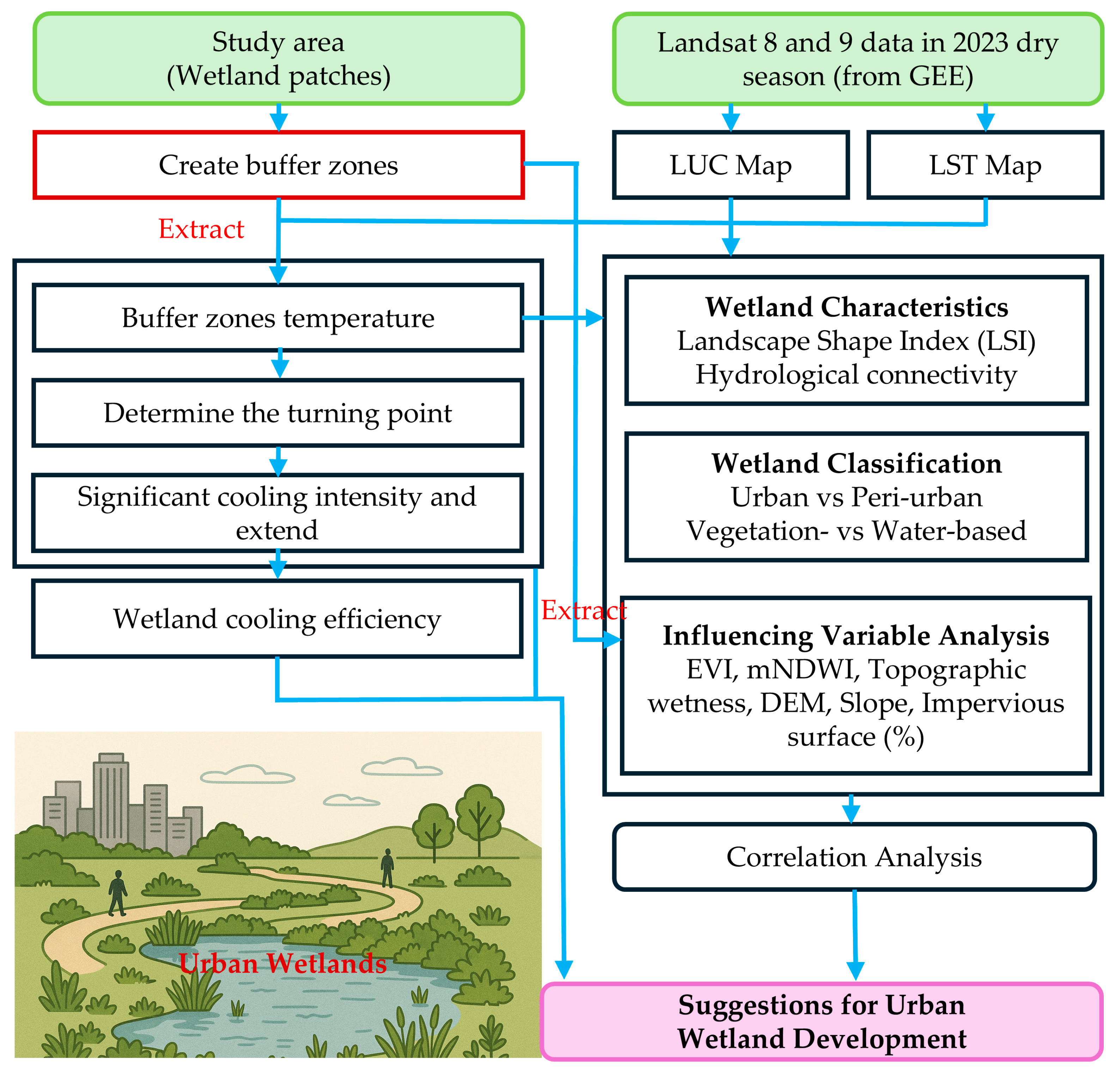
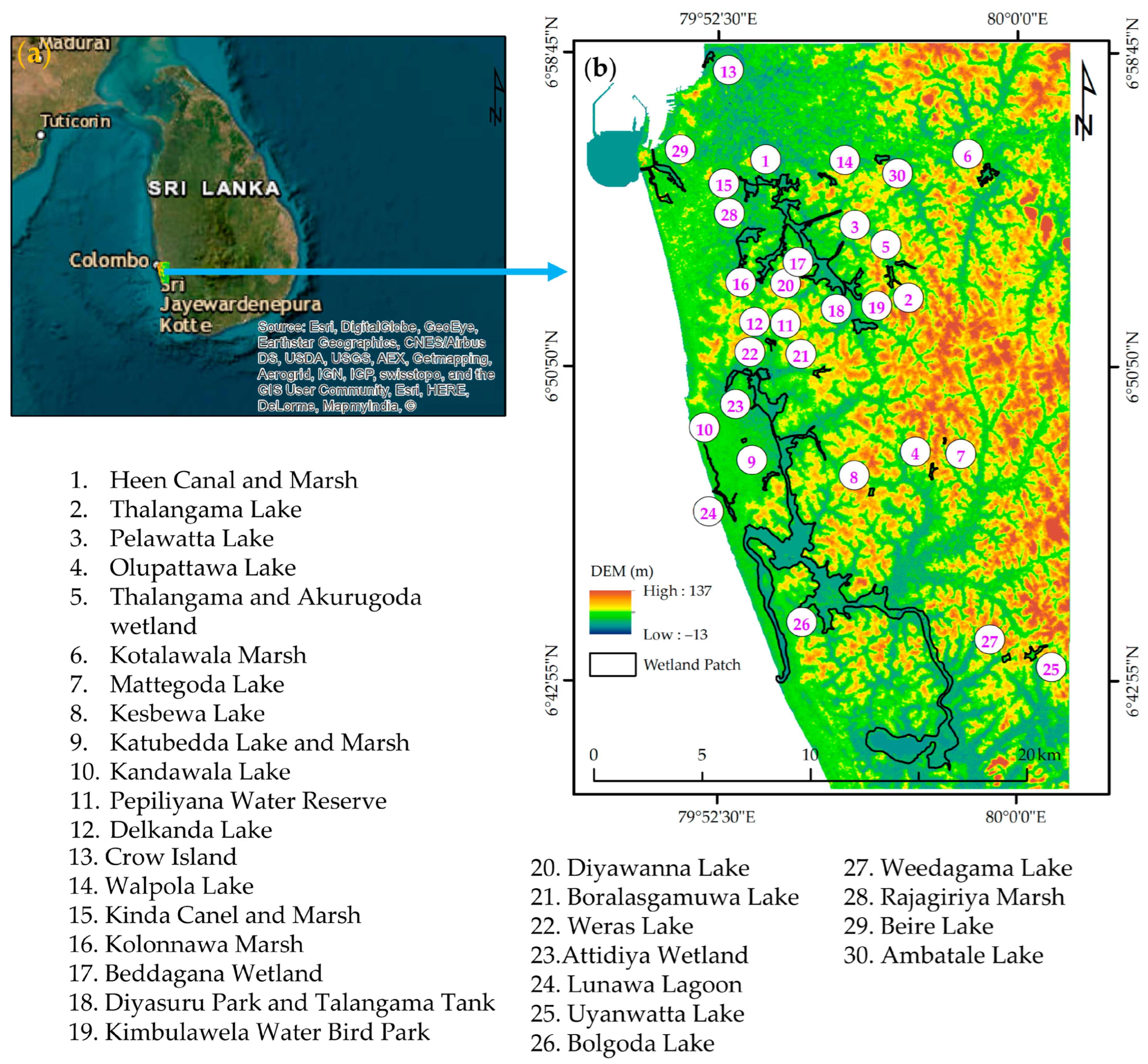
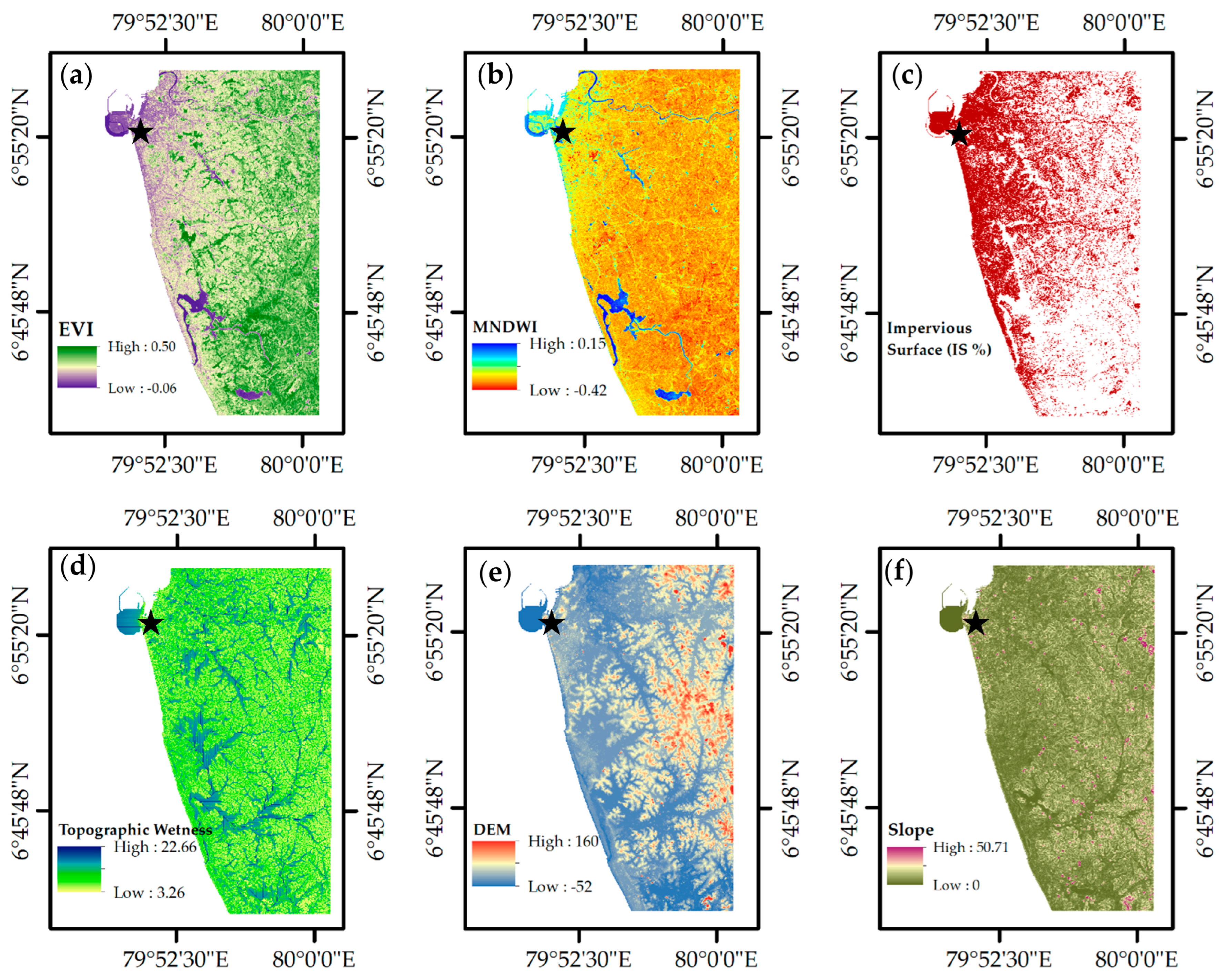
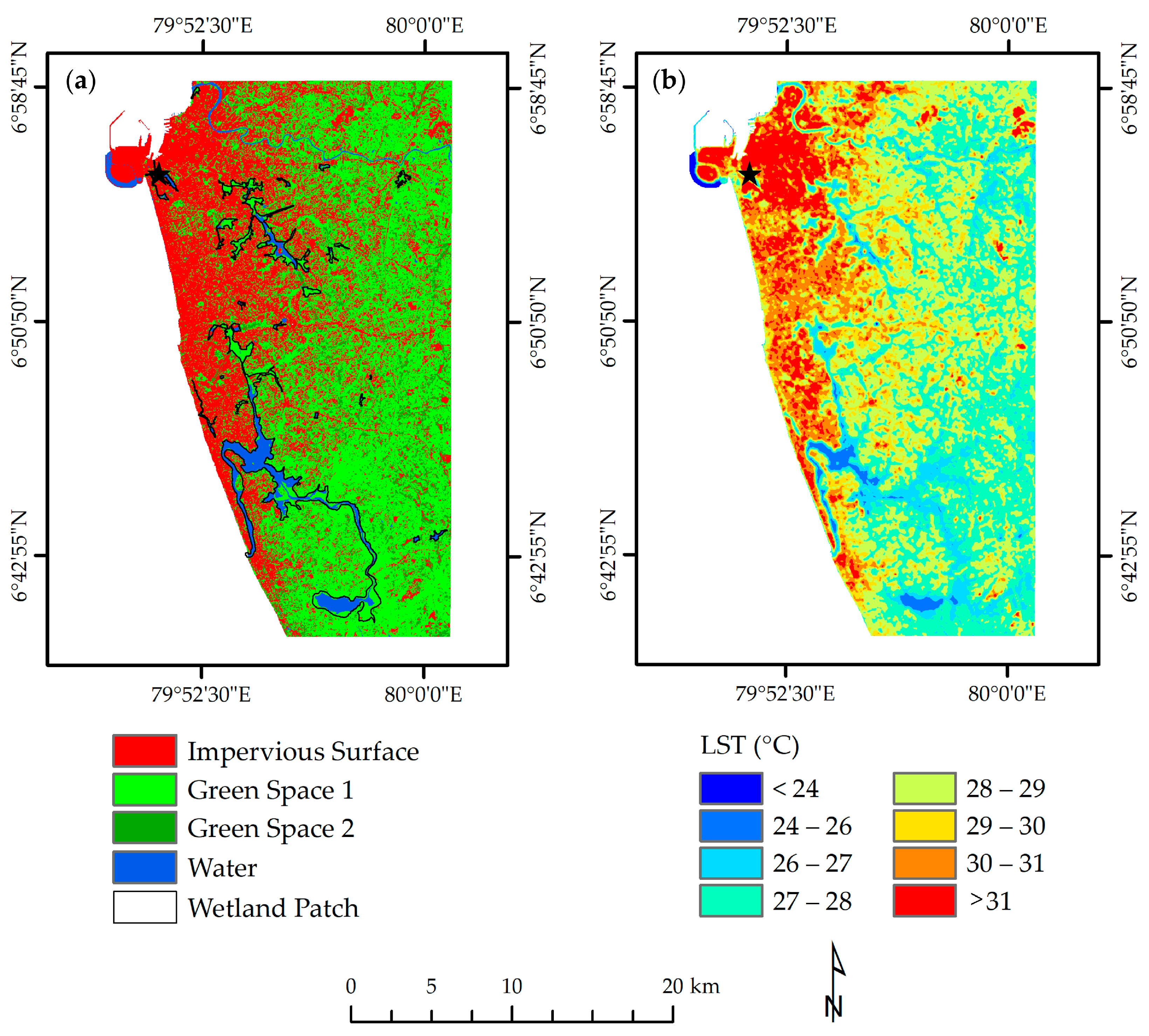
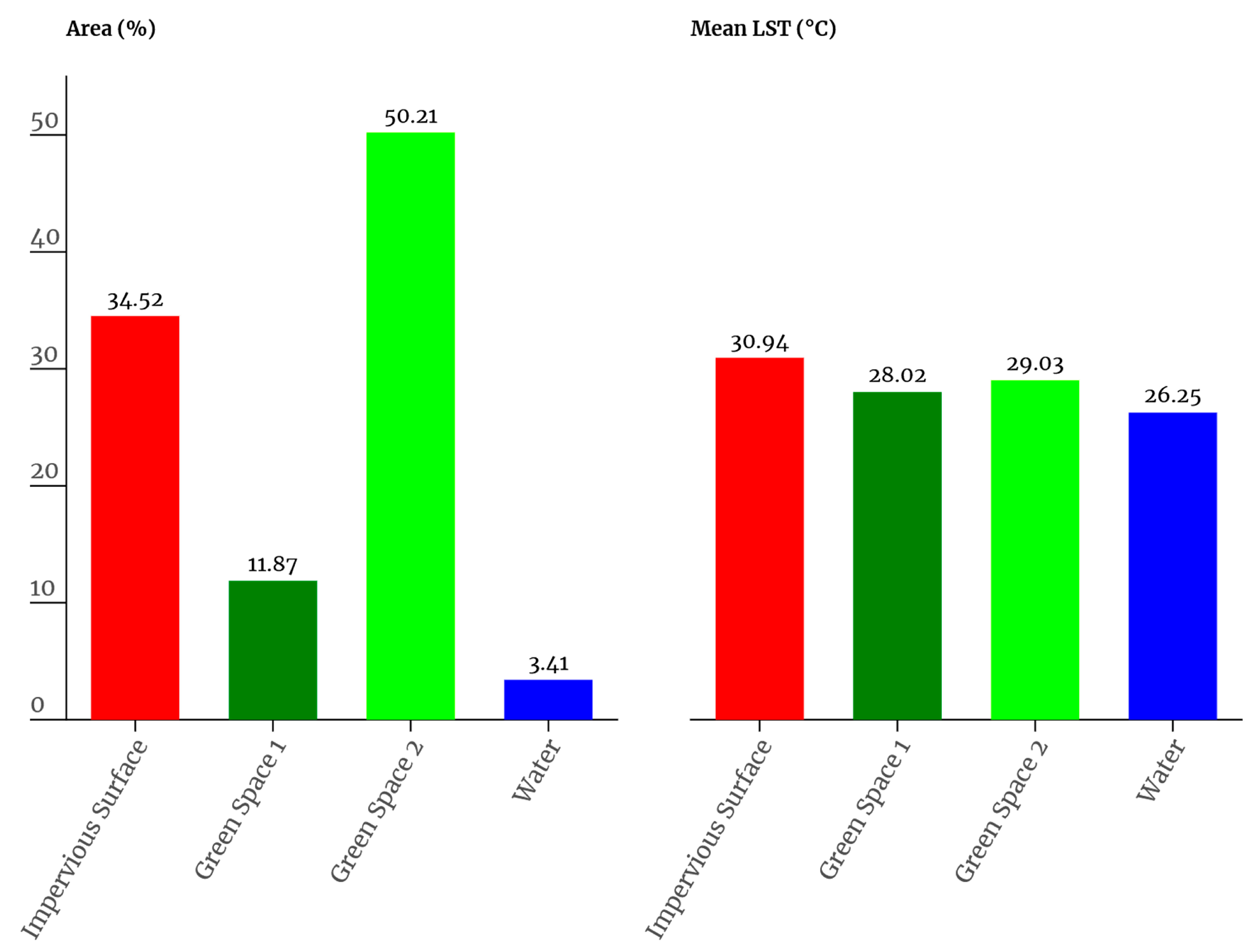
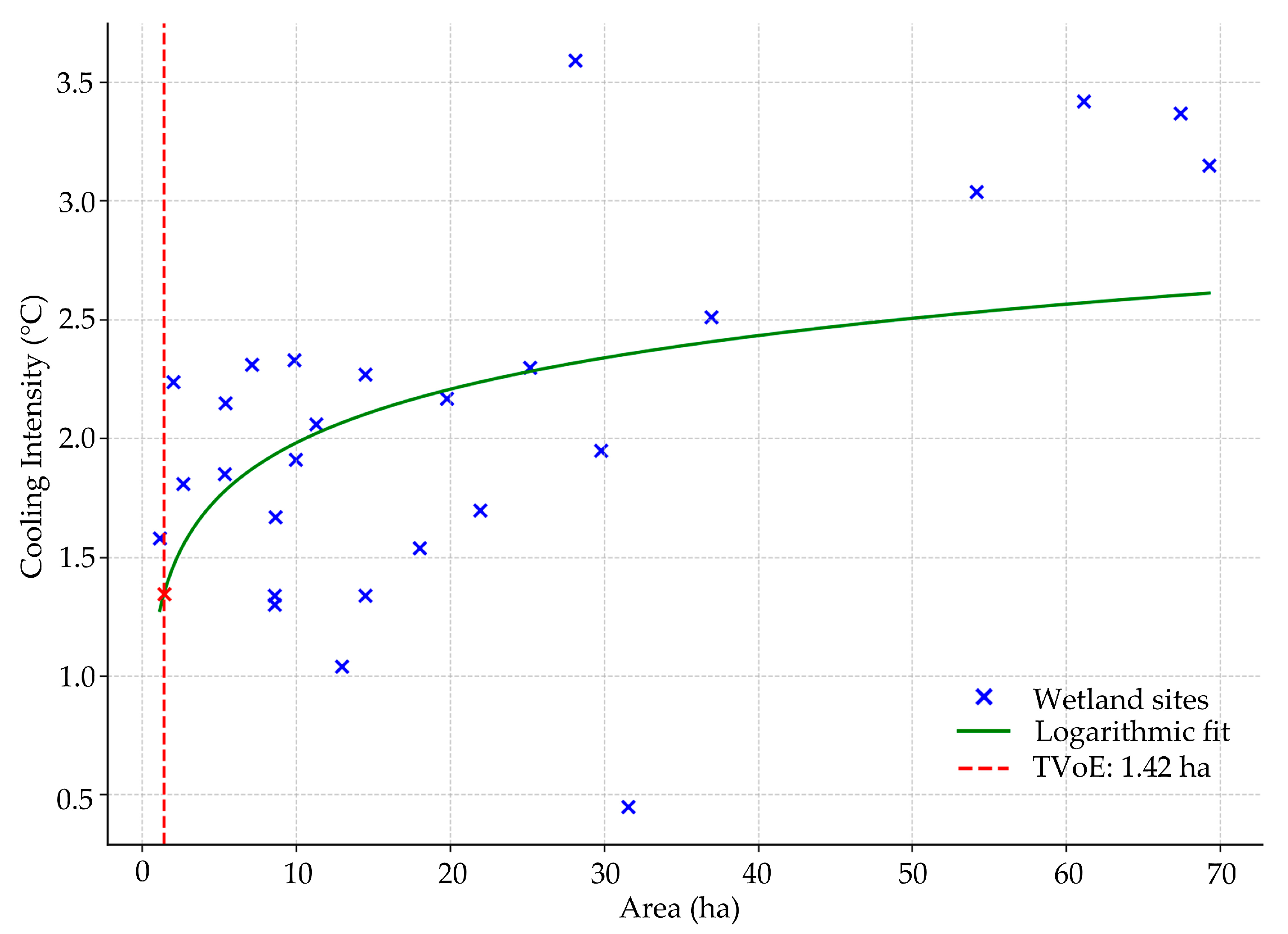
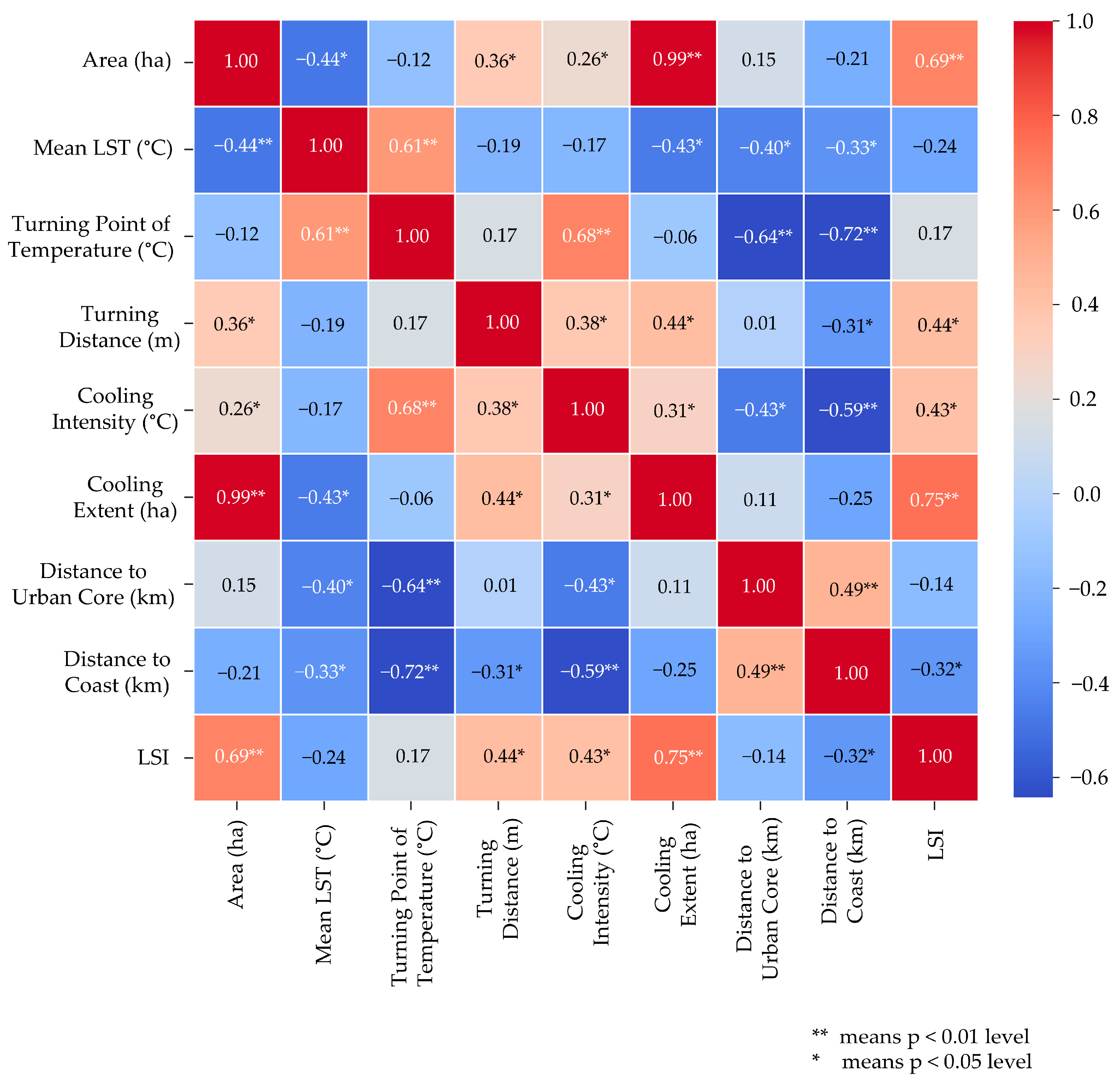
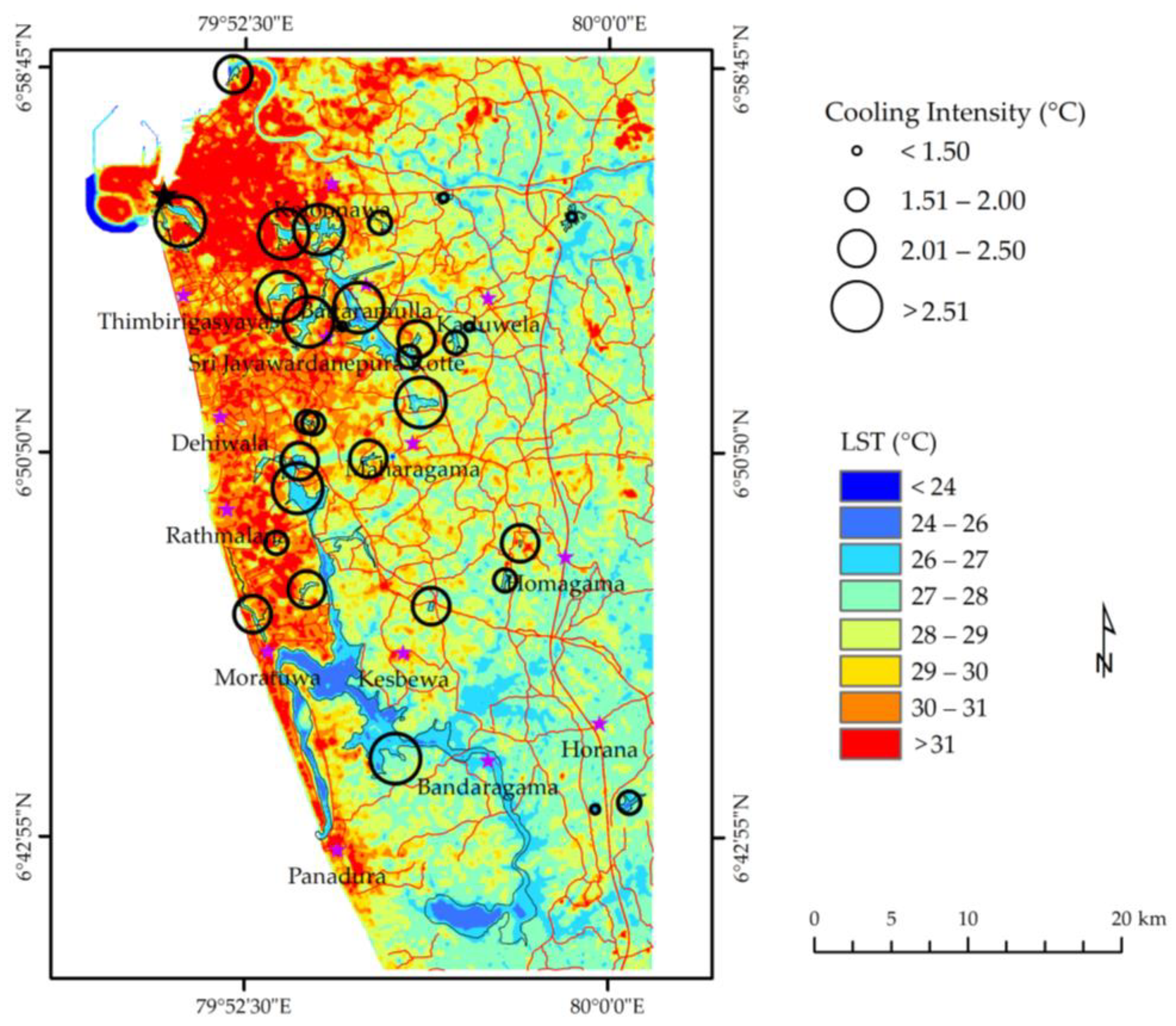
| Parameter | Unit | Mean | Standard Deviation | Minimum | Maximum |
|---|---|---|---|---|---|
| Area | ha | 93.94 | 327.72 | 1.15 | 1805.17 |
| Mean LST | °C | 28.05 | 0.70 | 26.51 | 29.60 |
| Turning Point Temperature | °C | 30.22 | 0.95 | 28.57 | 31.96 |
| Turning Distance | m | 285.00 | 93.80 | 120.00 | 450.00 |
| Cooling Intensity | °C | 2.17 | 0.76 | 0.45 | 3.59 |
| Cooling Extent | ha | 284.43 | 693.68 | 19.00 | 3848.00 |
| Temperature Gradient to 1 km | °C | 7.24 | 2.54 | 1.51 | 11.95 |
| Distance to Urban Core | km | 12.55 | 6.27 | 0.60 | 29.10 |
| Distance to Coast | km | 6.4 | 3.82 | 0.1 | 15.8 |
| LSI | - | 2.54 | 1.37 | 1.09 | 6.97 |
| Hydrological Connectivity | - | - | - | 0 | 1 |
| Variable | Average Value | Standard Deviation | Minimum | Maximum |
|---|---|---|---|---|
| EVI | −0.6492 | −0.2400 | −0.9307 | −0.1531 |
| MNDWI | 0.1208 | 0.4432 | −0.8376 | 0.7761 |
| Topographic wetness | −0.3079 | −0.1219 | −0.5618 | −0.0654 |
| DEM | 0.5748 | 0.2006 | 0.1364 | 0.8443 |
| Slope | 0.2556 | 0.1237 | 0.1085 | 0.6010 |
| Impervious surface (%) | 0.5816 | 0.2288 | 0.1610 | 0.9696 |
Disclaimer/Publisher’s Note: The statements, opinions and data contained in all publications are solely those of the individual author(s) and contributor(s) and not of MDPI and/or the editor(s). MDPI and/or the editor(s) disclaim responsibility for any injury to people or property resulting from any ideas, methods, instructions or products referred to in the content. |
© 2025 by the authors. Licensee MDPI, Basel, Switzerland. This article is an open access article distributed under the terms and conditions of the Creative Commons Attribution (CC BY) license (https://creativecommons.org/licenses/by/4.0/).
Share and Cite
Athukorala, D.; Murayama, Y.; Herath, N.S.K.; Madduma Bandara, C.M.; Singh, R.K.; Fernando, S.L.J. Exploring the Cooling Effects of Urban Wetlands in Colombo City, Sri Lanka. Remote Sens. 2025, 17, 1919. https://doi.org/10.3390/rs17111919
Athukorala D, Murayama Y, Herath NSK, Madduma Bandara CM, Singh RK, Fernando SLJ. Exploring the Cooling Effects of Urban Wetlands in Colombo City, Sri Lanka. Remote Sensing. 2025; 17(11):1919. https://doi.org/10.3390/rs17111919
Chicago/Turabian StyleAthukorala, Darshana, Yuji Murayama, N. S. K. Herath, C. M. Madduma Bandara, Rajeev Kumar Singh, and S. L. J. Fernando. 2025. "Exploring the Cooling Effects of Urban Wetlands in Colombo City, Sri Lanka" Remote Sensing 17, no. 11: 1919. https://doi.org/10.3390/rs17111919
APA StyleAthukorala, D., Murayama, Y., Herath, N. S. K., Madduma Bandara, C. M., Singh, R. K., & Fernando, S. L. J. (2025). Exploring the Cooling Effects of Urban Wetlands in Colombo City, Sri Lanka. Remote Sensing, 17(11), 1919. https://doi.org/10.3390/rs17111919







